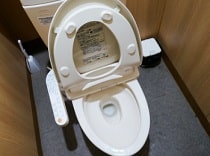Before entering fully into the meaning of the term toilet, we are going to proceed to know its etymological origin. In this case, we can emphasize that it derives from Latin, exactly from the word "inodorus", which is the result of the sum of the following lexical components:
-The prefix «in-«, which is used to indicate «no» or «without».
-The noun "odor", which can be translated as "smell".
-The suffix "-ius", which is used to indicate "relationship".
The first meaning of toilet mentioned by the Royal Spanish Academy ( RAE ) refers to what lacks odor .
 The sensation that an effluvium generates in the sense of smell is called odor. The odorless, therefore, does not produce such an impression: it has no aroma or fragrance . For example: «Carbon monoxide is very dangerous since, as it is an odorless gas, people do not perceive it and inhale it without realizing it» , «This product has an invisible and odorless coating that makes it waterproof» , « When it is raw it is odorless, but when it comes into contact with fire it begins to emanate a strong stench .
The sensation that an effluvium generates in the sense of smell is called odor. The odorless, therefore, does not produce such an impression: it has no aroma or fragrance . For example: «Carbon monoxide is very dangerous since, as it is an odorless gas, people do not perceive it and inhale it without realizing it» , «This product has an invisible and odorless coating that makes it waterproof» , « When it is raw it is odorless, but when it comes into contact with fire it begins to emanate a strong stench .
The concept of toilet is also used to name the sanitary device that allows the evacuation of urine and feces . In some regions, this device is known as a toilet , toilet , toilet or toilet .
Located in bathrooms , toilets are used by people when they want to urinate or defecate. These devices are installed in such a way that they can send the waste through a pipe or sewage pipe, where it is carried to a wastewater treatment plant. Thanks to having a siphon , unpleasant odors from the sewer do not come out through the device (hence its name).
There is a long list of toilets for sale, among which we can highlight high tank ones, low tank ones, suspended ones, compact ones, portable ones... However, among the most significant are, without a doubt, the Japanese toilets.
These Asian devices have the particularity of incorporating internal water jets with the clear objective of further improving personal hygiene. Hence, they are considered very practical and functional models that, little by little, are increasing their demand considerably throughout the world.
Toilets are generally made of porcelain , although other waterproof materials can be used. Due to the bacteria and other microorganisms present in stools, it is important to clean and disinfect them regularly.
In the same way, we cannot ignore that one of the best-known works of art by the Frenchman Marcel Duchamp (1887 – 1968) is precisely that of a toilet. This work is known under the title of "The Source", which was presented publicly in 1917 under the pseudonym R. Mutt 1917 and is considered one of the most influential of the entire 20th century.
